
Did Amazon’s 2023 Prime Day promotion pay off?
In July 2015, Amazon created Prime Day – a 24-hour nine-country promotion ostensibly launched to celebrate the company’s 20th birthday, with the aim of “offering a volume of deals greater than Black Friday, exclusively for Prime members.” While the summer months were perhaps not the most intuitive time to launch a sales event, Prime Day has endured.
Eight years later, 2023’s Prime Day expanded its runtime to 48 hours, extended its reach into some 20 markets, and, as YouGov BrandIndex data reveals, is still appealing to British consumers. In the week prior to the end of 2023’s Prime Day (a period covering 5-12 July), Word of Mouth exposure, a measure of whether the public have talked about a brand with friends and family, rose from 28.9 to 36.2 (+7.3).
Most of this conversation about Amazon Prime appears to have been positive: Buzz scores, which track whether consumers have heard anything good or bad about a brand, more than doubled from 9.0 to 20.5 over the same timeframe (+11.5). Correspondingly, overall Impression scores for the service, which measure general sentiment towards a brand, jumped from 30.5 to 38.5 (+8.0).
Perhaps unsurprisingly, discounts tend to improve Customer Satisfaction: this metric increased from 41.0 to 47.9 (+6.9), while Quality scores went from 28.5 to 35.1 (+6.6). Index scores, which track perceptions of the service’s brand health, also jumped from 28.9 to 34.2 (+5.3).
Amazon itself has reported that the 2023 edition of Prime Day has been the biggest yet. Along with Alibaba’s appropriation of Singles’ Day, it’s the kind of story that shows that large retailers don’t necessarily have to restrict themselves to the traditional sales periods if they can come up with a solid pretext and some enticing deals – even in the traditionally lean summer months.